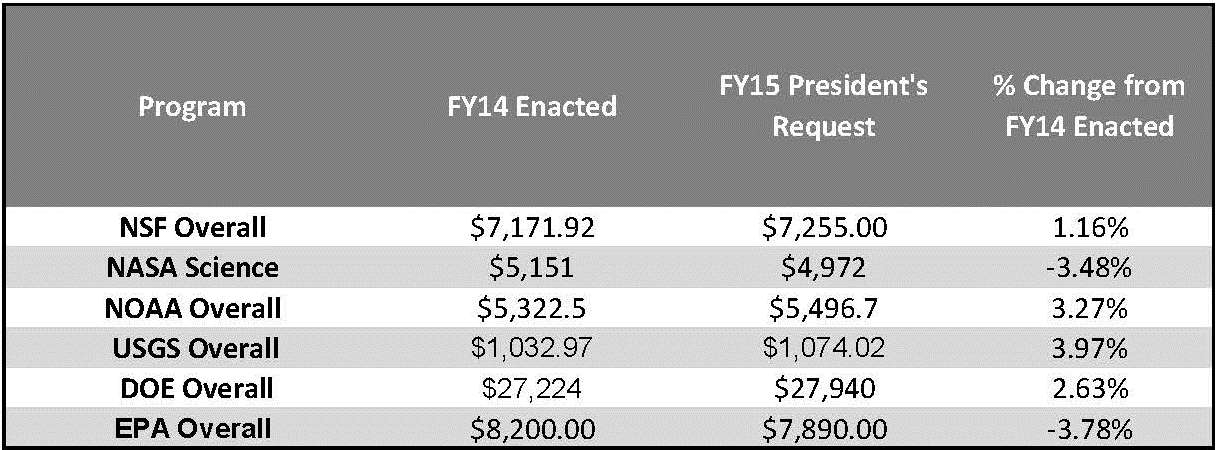March 21, 2014
The President’s Budget Request: A Mixed Bag for Science
Posted by Nick Saab
Written By Chris McEntee, AGU Executive Director
The President’s budget request for Fiscal Year 2015 (FY15) is a mixed bag for science. According to the White House, the FY15 budget request strives to build on the progress made by Congress with the recent omnibus passage, while continuing to cut the deficit in a balanced way. Republicans on Capitol Hill, however, rejected the budget out-of-hand. For Earth and space science, the proposed budget contains both good and bad news.
Overall, the request calls for $135.4 billion in federal R&D funding with $65.9 billion for non-defense research and development (R&D) (up 0.7% or $477 million from the FY14 enacted level) and $69.5 billion for defense R&D (up $1.2 billion or 1.7% from FY14 enacted). While these increases appear promising overall, sadly, basic research (at $32.1 billion) represents less than half of this research investment —which means that less than 25% of the total federal investment in R&D is targeted to basic research, research that drives the innovation and discovery that is fundamental to addressing societal challenges, fostering economic health and protecting national security.
By far, the most controversial provision is the $56 billion for what the Administration calls the “Opportunity, Growth, and Security Initiative (OGS Initiative).” The main purpose of the OGS Initiative is to show what the Administration would fund if the budget caps under Ryan-Murray and/or the limitations put in place by the sequester did not exist. The hefty sum is meant to nourish agencies and program areas, including the National Science Foundation ($500 million), NASA ($900 million), NOAA ($180 million) and the National Institute of Health ($1 billion), which were all affected by the sharp spending cuts known as the sequester. OGS also included $1 billion to better understand, combat, and prepare for climate change. While strategically OGS would increase science funding to address significant societal issues, by failing to include these funds into the agency budget requests, it is difficult to see how Congress can best integrate these amounts into the appropriations process.
The President’s FY15 budget request to Congress certainly offers a better outlook for science funding, particularly climate research, than the sequester. That said, it is a far cry from President Obama’s State of the Union speech where he made clear that an “all-in approach to innovation” was the best strategy for growing the economy. R&D funding in the President’s FY15 request is now at its lowest level as a percentage of total US funding in history, according to the American Association for the Advancement of Science. Yet, the need for increased investment touches our lives every day whether it is the latest wildfire in the West, the severe drought in California, or severe weather that has led to over one million cancelled or delayed airline flights this winter. Increased investments in Earth and space science are needed in order to protect public safety, foster economic growth, protect national security and spark interest to create a future generation of scientists. All of us need to work together to assure that Members of Congress and the White House understand that science is not a partisan issue; it is an American public issue and needs to be protected and nurtured for our future posterity. You can join in communicating the value of science by participating in AGU’s Sharing Science program.
For more on AGU’s coverage of President Obama’s FY15 budget proposal, you can read our initial reporting in Eos on the budget request, as well as an article focusing specifically on proposal’s impact on NASA.


